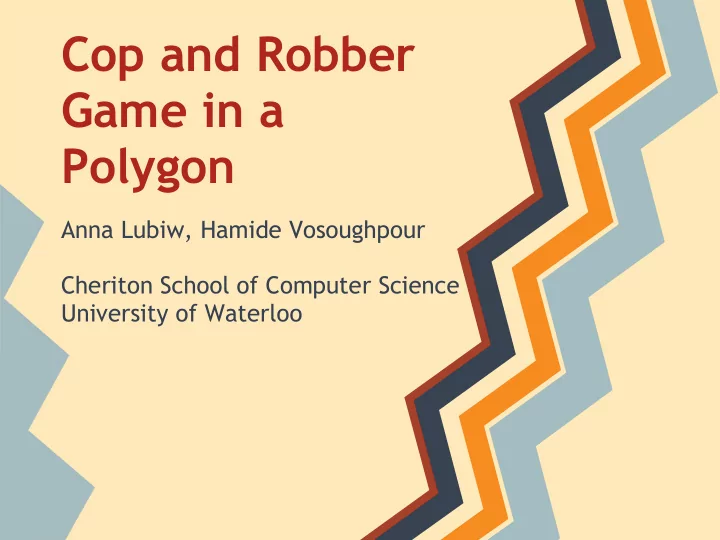

Cop and Robber Game in a Polygon Anna Lubiw, Hamide Vosoughpour Cheriton School of Computer Science University of Waterloo
Cop and Robber Game in Polygons Visibility Graphs Dismantlable Graphs
Visibility Graph V = vertices E = ( u , v ): u sees v Characterization and recognition is still an open problem.
Cop and Robber Game ● cop & robber on vertices ● take turns, move on edges Vertex 2 dominates vertex 4: N[4] ⊆ N[2]
Dismantlable Ordering Vertex ordering of G=(V,E) v 1 v 2 ... v n s.t. v i dominated by some v j , j>i in G i (the subgraph of vertices v i , ..., v n ) 1 dominated by 4 2 dominated by 5 in G 2
Dismantlability and Cop-win Theorem by Nowakowski and Winkler 1982: A graph G=(V,E) is cop-win iff dismantlable. ● recognition in polynomial time ● cop optimal strategy in polynomial time ● number of turns bounded by n
2-Dismantlablity The graph has at least 2 dominated vertices u 1 and u 2 and G - u 1 -u 2 is 2-dismantlable recursively. ● number of turns bounded by n/2
Visibility Graphs Dismantlable Graphs
Visibility Graphs are Dismantlable Proved by Aichholzer et al. 2011 Idea: A maximal pocket gives a dominated vertex ● pocket (u,v) maximal by containment. ● pocket (u',v') not maximal ● pocket (u,v) maximal ⇒ u is dominated by v .
Visibility Graphs are Dismantlable Remove u from visibility graph ~ Remove △ uvw from polygon
Cops and Robbers on Visibility Graph ● always cop-win ● the cop may only use reflex vertices to win ● the game finishes after r turns (number of reflex vertices)
Visibility Graphs are 2-Dismantlable u dominated by v u' dominated by v'
Cops and Robbers in Polygons ● Take turns ● Move on straight line inside the polygon ● Have full information about each other's location ● Cop's goal is to capture the robber, i.e. move to robber's position.
Background on Pursuit Evasion ● Continuous vs discrete space (limited speed ) ● Continuous vs discrete moves (man and lion problem) ● Capture vs see the evader. ● Group of pursuers vs a single pursuer. ● Full information vs partial/no information about the evader's position.
Our Result Infinite Visibility Graph ● Vertex for every point inside polygon. ● Edge (p,q) if p sees q . We Prove ○ The game is cop-win ○ Using 2-dismantlable ordering of triangles in polygons.
Proof Idea Successively remove dominated triangles. R dominated by v if all points p ∊ R are dominated by v i.e. p sees t ⇒ v sees t. triangles' vertices are not necessarily polygon vertices.
Dominated Triangle If boundary of △ vum is dominated by v , all points q inside the triangle are also dominated.
How to choose point m ? ● Pocket (u,v) is maximal ● m is reflex collinear ● get O(n 2 ) triangles.
Simple Strategy We also showed a simple cop move rule to win: The cop goes to the first step on the shortest path to the robber.
Conclusions ● Provide one answer to Hahn's question (2002) of finding non-trivial classes of infinite cop-win graphs ● One step into visibility graph characterization. ● The more natural way to model pursuit evasion problem than limited speed for real polygonal environments.
Open Questions ● How hard is to find the optimal cop strategy ○ polynomial when the cop is limited to vertices (maybe boundary)
Open Questions ● How hard is to find the optimal cop strategy ○ polynomial when the cop is limited to vertices (maybe boundary) ● Game in curvy environments ○ no winning strategy for cop moving on boundary
Open Questions ● How hard is to find the optimal cop strategy ○ polynomial when the cop is limited to vertices (maybe boundary) ● Game in curvy environments ○ no winning strategy for cop moving on boundary ● Number of sufficient cops in polygons with holes ○ 3 cops are needed in some situations (based on the plannar graph by Aigner and Fromme (1984) that needs 3 cops)
THANK YOU
Recommend
More recommend